remove seats TESLA MODEL S 2015 クイックガイド (in Japanese)
[x] Cancel search | Manufacturer: TESLA, Model Year: 2015, Model line: MODEL S, Model: TESLA MODEL S 2015Pages: 96, PDF Size: 2.86 MB
Page 9 of 96
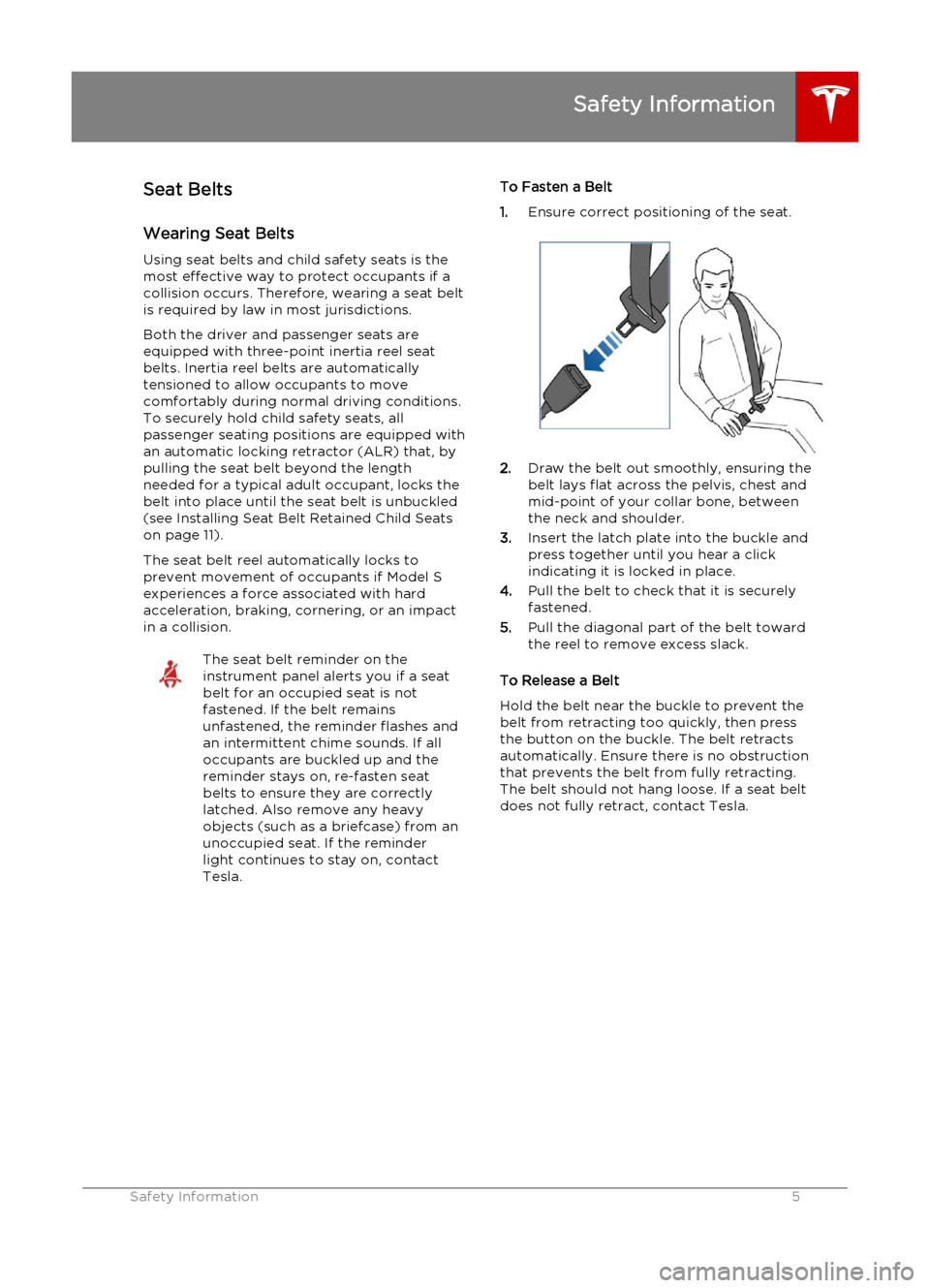
Seat BeltsWearing Seat Belts
Using seat belts and child safety seats is the
most effective way to protect occupants if a
collision occurs. Therefore, wearing a seat belt
is required by law in most jurisdictions.
Both the driver and passenger seats are equipped with three-point inertia reel seatbelts. Inertia reel belts are automatically
tensioned to allow occupants to move
comfortably during normal driving conditions.
To securely hold child safety seats, all
passenger seating positions are equipped with an automatic locking retractor (ALR) that, by
pulling the seat belt beyond the length
needed for a typical adult occupant, locks the belt into place until the seat belt is unbuckled
(see Installing Seat Belt Retained Child Seats
on page 11).
The seat belt reel automatically locks to prevent movement of occupants if Model S
experiences a force associated with hard
acceleration, braking, cornering, or an impact in a collision.The seat belt reminder on the
instrument panel alerts you if a seat
belt for an occupied seat is not
fastened. If the belt remains
unfastened, the reminder flashes and
an intermittent chime sounds. If all
occupants are buckled up and the
reminder stays on, re-fasten seat
belts to ensure they are correctly
latched. Also remove any heavy
objects (such as a briefcase) from an
unoccupied seat. If the reminder
light continues to stay on, contact
Tesla.To Fasten a Belt
1. Ensure correct positioning of the seat.
2.
Draw the belt out smoothly, ensuring the
belt lays flat across the pelvis, chest and
mid-point of your collar bone, between
the neck and shoulder.
3. Insert the latch plate into the buckle and
press together until you hear a click indicating it is locked in place.
4. Pull the belt to check that it is securely
fastened.
5. Pull the diagonal part of the belt toward
the reel to remove excess slack.
To Release a Belt
Hold the belt near the buckle to prevent the
belt from retracting too quickly, then press
the button on the buckle. The belt retracts
automatically. Ensure there is no obstruction
that prevents the belt from fully retracting.
The belt should not hang loose. If a seat belt does not fully retract, contact Tesla.
Safety Information
Safety Information5
Page 15 of 96
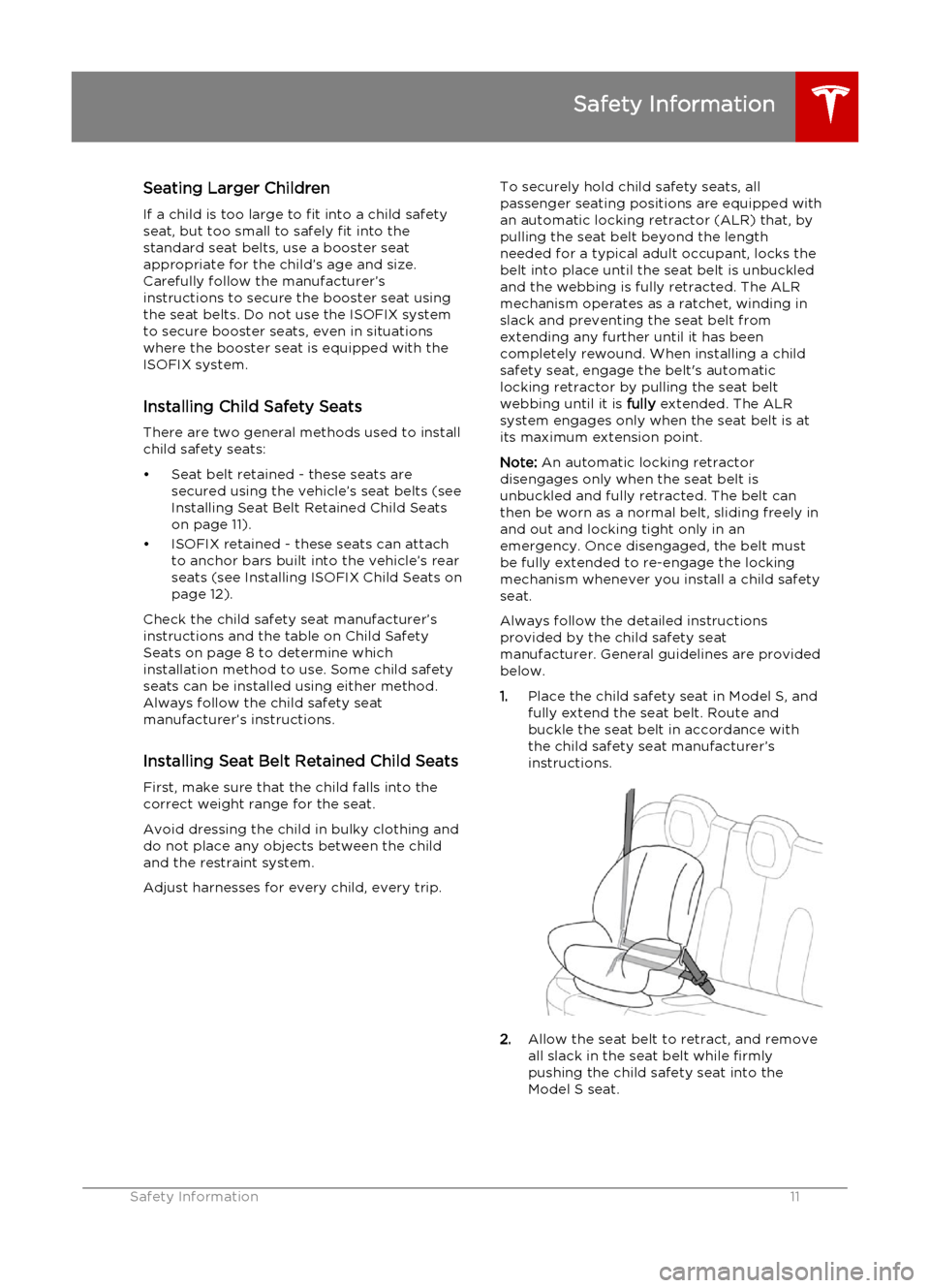
Seating Larger Children
If a child is too large to fit into a child safety
seat, but too small to safely fit into the standard seat belts, use a booster seat
appropriate for the child’s age and size. Carefully follow the manufacturer’s
instructions to secure the booster seat using
the seat belts. Do not use the ISOFIX system to secure booster seats, even in situationswhere the booster seat is equipped with the
ISOFIX system.
Installing Child Safety Seats
There are two general methods used to install child safety seats:
• Seat belt retained - these seats are secured using the vehicle’s seat belts (see
Installing Seat Belt Retained Child Seats
on page 11).
• ISOFIX retained - these seats can attach to anchor bars built into the vehicle’s rear
seats (see Installing ISOFIX Child Seats on
page 12).
Check the child safety seat manufacturer’s
instructions and the table on Child Safety
Seats on page 8 to determine which
installation method to use. Some child safety
seats can be installed using either method.
Always follow the child safety seat
manufacturer’s instructions.
Installing Seat Belt Retained Child Seats
First, make sure that the child falls into the
correct weight range for the seat.
Avoid dressing the child in bulky clothing and do not place any objects between the child
and the restraint system.
Adjust harnesses for every child, every trip.To securely hold child safety seats, all
passenger seating positions are equipped with
an automatic locking retractor (ALR) that, by pulling the seat belt beyond the length
needed for a typical adult occupant, locks the
belt into place until the seat belt is unbuckled
and the webbing is fully retracted. The ALR
mechanism operates as a ratchet, winding in
slack and preventing the seat belt from
extending any further until it has been
completely rewound. When installing a child
safety seat, engage the belt's automatic
locking retractor by pulling the seat belt
webbing until it is fully extended. The ALR
system engages only when the seat belt is at its maximum extension point.
Note: An automatic locking retractor
disengages only when the seat belt is
unbuckled and fully retracted. The belt can then be worn as a normal belt, sliding freely inand out and locking tight only in an
emergency. Once disengaged, the belt must be fully extended to re-engage the locking
mechanism whenever you install a child safety seat.
Always follow the detailed instructions provided by the child safety seat
manufacturer. General guidelines are provided
below.
1. Place the child safety seat in Model S, and
fully extend the seat belt. Route and
buckle the seat belt in accordance with the child safety seat manufacturer’s
instructions.
2. Allow the seat belt to retract, and remove
all slack in the seat belt while firmly
pushing the child safety seat into the Model S seat.
Safety Information
Safety Information11
Page 18 of 96
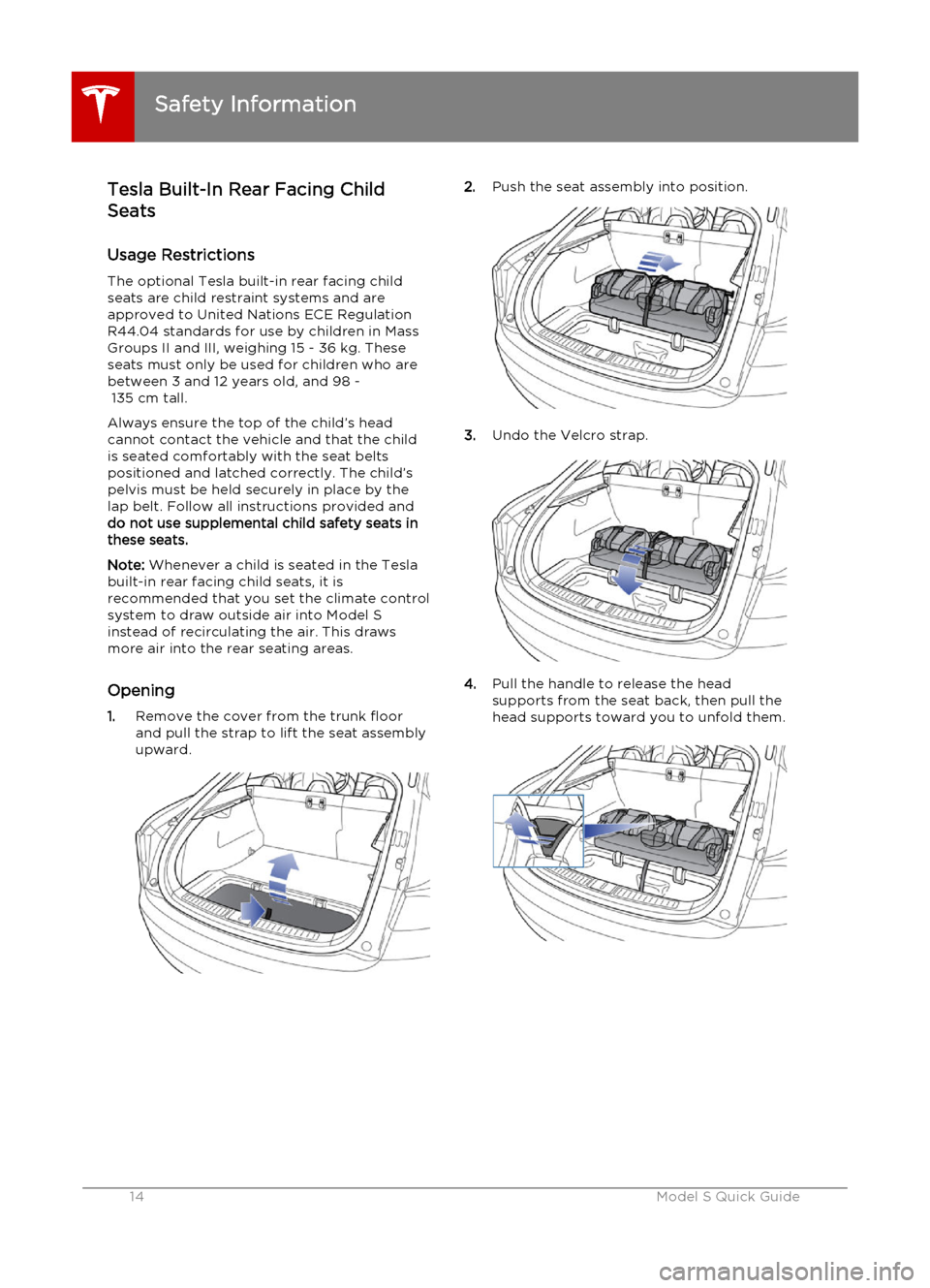
Tesla Built-In Rear Facing Child
Seats
Usage Restrictions
The optional Tesla built-in rear facing child
seats are child restraint systems and are approved to United Nations ECE Regulation
R44.04 standards for use by children in Mass
Groups II and III, weighing 15 - 36 kg. These
seats must only be used for children who are
between 3 and 12 years old, and 98 -
135 cm tall.
Always ensure the top of the child’s head cannot contact the vehicle and that the child
is seated comfortably with the seat belts
positioned and latched correctly. The child’s
pelvis must be held securely in place by the
lap belt. Follow all instructions provided and
do not use supplemental child safety seats in
these seats.
Note: Whenever a child is seated in the Tesla
built-in rear facing child seats, it is
recommended that you set the climate control
system to draw outside air into Model S
instead of recirculating the air. This draws
more air into the rear seating areas.
Opening 1. Remove the cover from the trunk floor
and pull the strap to lift the seat assembly upward.2. Push the seat assembly into position.
3.Undo the Velcro strap.
4.Pull the handle to release the head
supports from the seat back, then pull the
head supports toward you to unfold them.
Safety Information
14Model S Quick Guide
Page 21 of 96
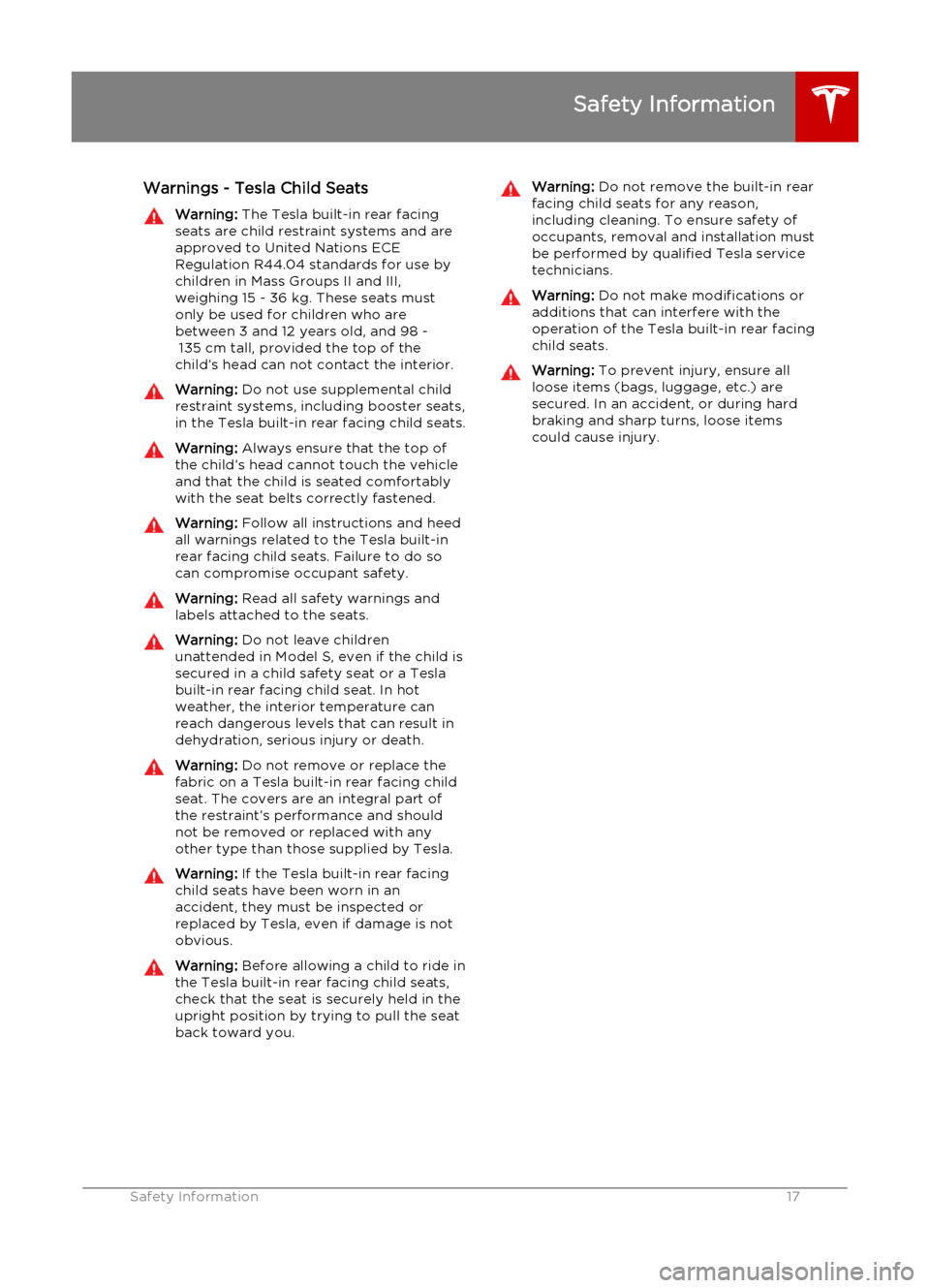
Warnings - Tesla Child SeatsWarning: The Tesla built-in rear facing
seats are child restraint systems and are approved to United Nations ECE
Regulation R44.04 standards for use by children in Mass Groups II and III,
weighing 15 - 36 kg. These seats must
only be used for children who are
between 3 and 12 years old, and 98 -
135 cm tall, provided the top of the
child’s head can not contact the interior.Warning: Do not use supplemental child
restraint systems, including booster seats,
in the Tesla built-in rear facing child seats.Warning: Always ensure that the top of
the child’s head cannot touch the vehicle and that the child is seated comfortablywith the seat belts correctly fastened.Warning: Follow all instructions and heed
all warnings related to the Tesla built-in
rear facing child seats. Failure to do so
can compromise occupant safety.Warning: Read all safety warnings and
labels attached to the seats.Warning: Do not leave children
unattended in Model S, even if the child is secured in a child safety seat or a Tesla
built-in rear facing child seat. In hot
weather, the interior temperature can reach dangerous levels that can result in
dehydration, serious injury or death.Warning: Do not remove or replace the
fabric on a Tesla built-in rear facing child
seat. The covers are an integral part of the restraint’s performance and shouldnot be removed or replaced with any
other type than those supplied by Tesla.Warning: If the Tesla built-in rear facing
child seats have been worn in an
accident, they must be inspected or
replaced by Tesla, even if damage is not
obvious.Warning: Before allowing a child to ride in
the Tesla built-in rear facing child seats, check that the seat is securely held in theupright position by trying to pull the seat
back toward you.Warning: Do not remove the built-in rear
facing child seats for any reason,
including cleaning. To ensure safety of
occupants, removal and installation must
be performed by qualified Tesla service
technicians.Warning: Do not make modifications or
additions that can interfere with the
operation of the Tesla built-in rear facing
child seats.Warning: To prevent injury, ensure all
loose items (bags, luggage, etc.) are
secured. In an accident, or during hard
braking and sharp turns, loose items
could cause injury.
Safety Information
Safety Information17
Page 24 of 96
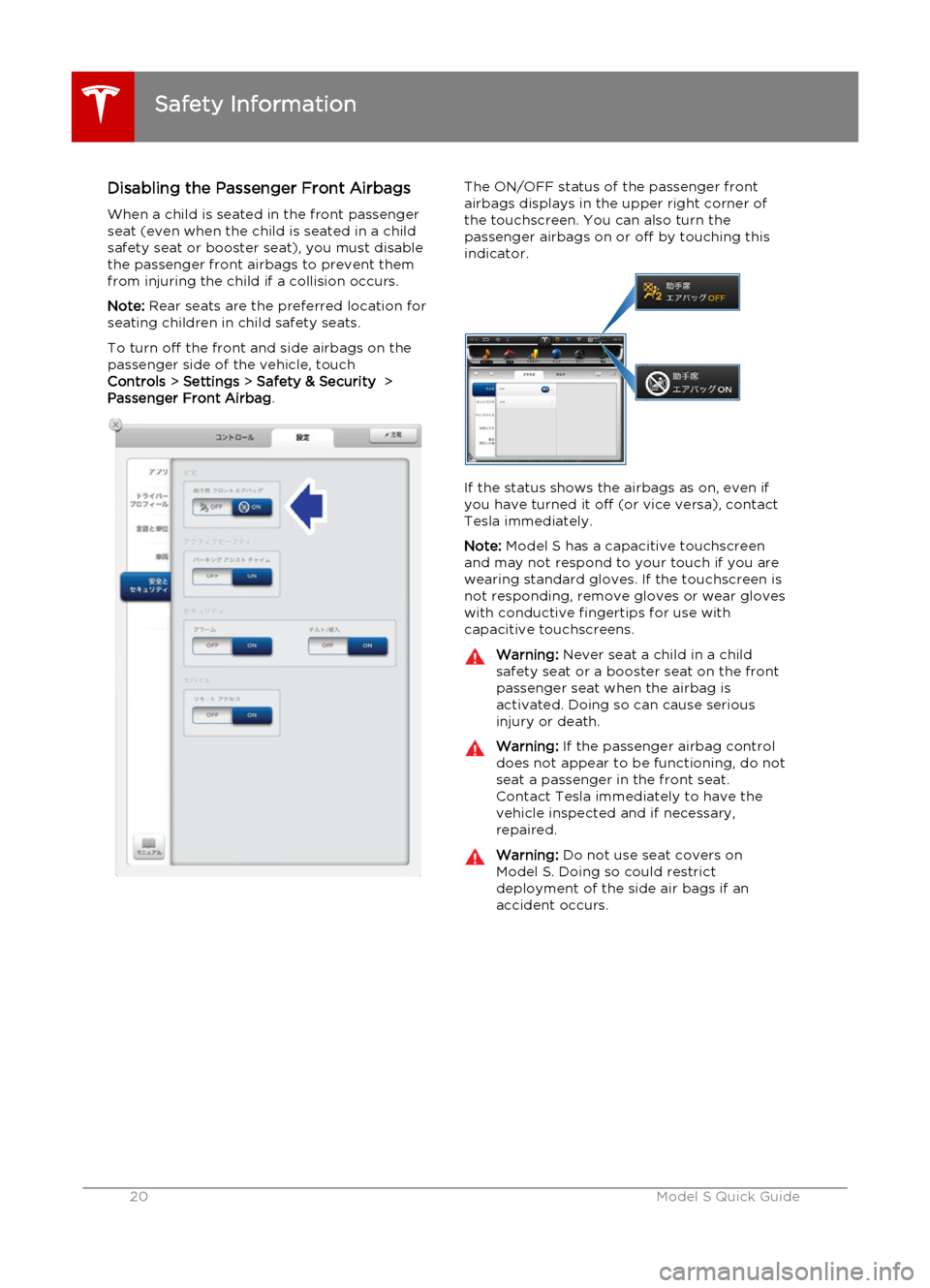
Disabling the Passenger Front AirbagsWhen a child is seated in the front passenger
seat (even when the child is seated in a child
safety seat or booster seat), you must disable the passenger front airbags to prevent them
from injuring the child if a collision occurs.
Note: Rear seats are the preferred location for
seating children in child safety seats.
To turn off the front and side airbags on the
passenger side of the vehicle, touch
Controls > Settings > Safety & Security >
Passenger Front Airbag .The ON/OFF status of the passenger front
airbags displays in the upper right corner of the touchscreen. You can also turn thepassenger airbags on or off by touching thisindicator.
If the status shows the airbags as on, even ifyou have turned it off (or vice versa), contact
Tesla immediately.
Note: Model S has a capacitive touchscreen
and may not respond to your touch if you are wearing standard gloves. If the touchscreen is
not responding, remove gloves or wear gloves
with conductive fingertips for use with capacitive touchscreens.
Warning: Never seat a child in a child
safety seat or a booster seat on the front
passenger seat when the airbag is
activated. Doing so can cause serious injury or death.Warning: If the passenger airbag control
does not appear to be functioning, do not
seat a passenger in the front seat.
Contact Tesla immediately to have the vehicle inspected and if necessary,
repaired.Warning: Do not use seat covers on
Model S. Doing so could restrict
deployment of the side air bags if an
accident occurs.
Safety Information
20Model S Quick Guide